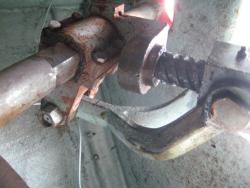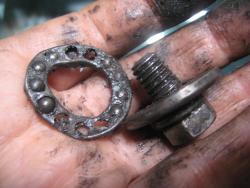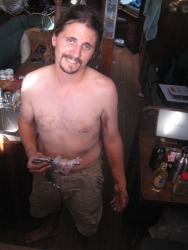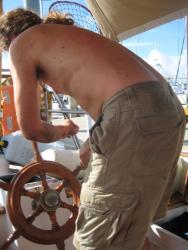Sailors have a tendency to be superstitious. Perhaps we're not good sailors, as Jamie and I tend to ignore the many superstitions out there -- we'll set sail on a Friday if the weather is favorable, we'll carry black traveling bags, we're not afraid of red headed strangers, we step on the boat with whatever foot is comfortable, and we'd never waste wine by pouring it on the deck for "good luck". I personally like the circular irony in the belief that it's bad luck to be superstitious. So when things start breaking, I really can't blame it on anything but our inexperience as we climb the steep learning curve.
We arrived in Charleston with no engine and no steering, with a rapidly dripping stuffing box filling our bilge. It was a holiday weekend, so there were no mechanics available to take our money. We spent one full day simply recovering, sleeping in and being lazy after the all night adventure I wrote about in my last blog entry. The second day we started digging into the many problems on our boat that had struck at the same time.
I started with the fuel flow issue. Having already confirmed the previous day that there was plenty of diesel in the forward tank, I got to work trying to figure out why the fuel wasn't flowing through the filters into the engine. I changed the filters, took lines apart, and studied the fuel system carefully to deduce what could possibly be causing our problems. In the end I had a good understanding of how this system worked, and it was quite clear that something was preventing fuel from getting from the fuel tank to the engine.
It was at this point that I thought I should recheck the fuel tanks. And moments later I felt like quite an idiot, when I discovered that what I thought was fuel on my dipstick was actually a fuel stain from thirty years of service. Our fuel flow issue was nothing more than an empty tank. Doing the math, it does make sense. We likely burn between 1/2 and 3/4 of a gallon an hour. We last filled up in early March. Three and a half months of running the boat daily to keep our batteries charged, motoring in and out of marinas and anchorages, and a few calm nights where we motored or motor sailed for long hours used up all 80 gallons of our forward fuel tank.
We always have plenty of fuel in reserve, with another 20 gallons in a stern tank which was still nearly full. There's not many places we couldn't get to in the 30-40 hours of running time that tank gives us.
Plenty embarrassing to admit this, but on the bright side we now have clean fuel filters and I now have a very good understanding of our fuel system. And, of course, we now have full fuel tanks again. Going forward, I will pay more attention to the hours we run our engine compared to the rate at which fuel is consumed, to try to find a more precise burn rate. And on that note, I hope you'll kindly forget about this little incident.
 The steering issue took a little more effort to solve. While climbing around under the cockpit trying to understand how the steering shaft was supposed to connect to the rudder, I found a mutilated metal piece with half a dozen metal balls in it. Studying it for a while, I realized that it went between the bolt and the end of the steering shaft, allowing the bolt to turn without spinning out.
The steering issue took a little more effort to solve. While climbing around under the cockpit trying to understand how the steering shaft was supposed to connect to the rudder, I found a mutilated metal piece with half a dozen metal balls in it. Studying it for a while, I realized that it went between the bolt and the end of the steering shaft, allowing the bolt to turn without spinning out.  That piece of the puzzle solved, I then called around until we found an outfit called Bearing Distributors, Inc on the outskirts of Charleston. The local marina kindly gave us a lift out there, and then within 15 minutes the gentleman behind the counter had matched up our mutilated piece of metal with a similarly sized thrust bearing. For $12.50, we had everything we needed to repair our steering.
That piece of the puzzle solved, I then called around until we found an outfit called Bearing Distributors, Inc on the outskirts of Charleston. The local marina kindly gave us a lift out there, and then within 15 minutes the gentleman behind the counter had matched up our mutilated piece of metal with a similarly sized thrust bearing. For $12.50, we had everything we needed to repair our steering.
 Crawling around under the cockpit in the stern of our sailboat is not a fun job, but it was still quite rewarding to install the new thrust bearing and find that our steering not only works but is now smoother than it ever was before.
Crawling around under the cockpit in the stern of our sailboat is not a fun job, but it was still quite rewarding to install the new thrust bearing and find that our steering not only works but is now smoother than it ever was before. 
As for the stuffing box, I stressed over that fix for an impressively long time. I imagined that when I removed the bolts from the stuffing box and opened it up to add more stuffing it would explode with gushing water quickly filling our boat, hopefully no faster than our bilge pumps could pump it back out. A mechanic I'd talked to and the books I read assured me it was a perfectly safe operation, but I wasn't looking forward to it. As it turned out, it went as smooth as could be. As I didn't remove the old stuffing (which I'd put in there only a couple of months ago), the water never came out faster than a slow trickle. And with the new stuffing material in place, the box returned to a slow drip as was appropriate. An easy fix.
The only other surprise in store for me this weekend was that my laptop decided to stop working. Fortunately I back it up regularly as it is my livelihood, and I was able to quickly track the problem down to a failed hard drive. Being a regular destroyer of hard drives, I had a spare on hand, and was able to quickly get up and running again. If only I knew as much about boats as I know about computers!
And so, Tuesday night our boat is fully operational again. The weather forecast is favorable, with 2-4 foot swells on the outside and 10-15 knot winds from the south helping to push us north. And our stomachs are full with some amazing shrimp and scallop gumbo that Jamie whipped up in honor of being in the South. The plan is to head outside tomorrow morning, once again bound for Beaufort, North Carolina, where we hope to arrive by Friday. From there we will most likely head inside all the way through the Chesapeake Bay. Jamie is hoping to attend an APTA conference in Baltimore that starts on June 10th, and where we'll also reunite with Bill and show off the skills we've mastered since he first started teaching us.
Yes, it's looking to be a pleasant voyage... what could possibly go wrong?
Mon, 06/01/2009 - 19:49
Great job doing those repairs. Get er done! And the fuel thing could happen to anyone. I remember my friend and I puzzling over why his car would not start for half an hour only to find out it was in Drive not Park. But sometimes those old fuel tanks have rust and can clog up a filter pretty well, alway a good idea to change fuel filters now and then.
From my nuts to your bolts,
-K
Wed, 05/27/2009 - 08:52
Congratulations on another successful chapter of boat living! I keep telling myself that each time I fix something it means one more project that I will be ready to do 'next time'. The down side of that is as you begin approaching my advanced age you start forgetting that you fixed it last time. :)
The pictures are great, and always help tell the story. I definitely don't remember seeing that bearing when I was crawling around back there, so I have learned something as well.
Enjoy the rest of the trip north. With a little luck and good fortune, I'll see you both in Baltimore in a few weeks!
fair winds,
Bill